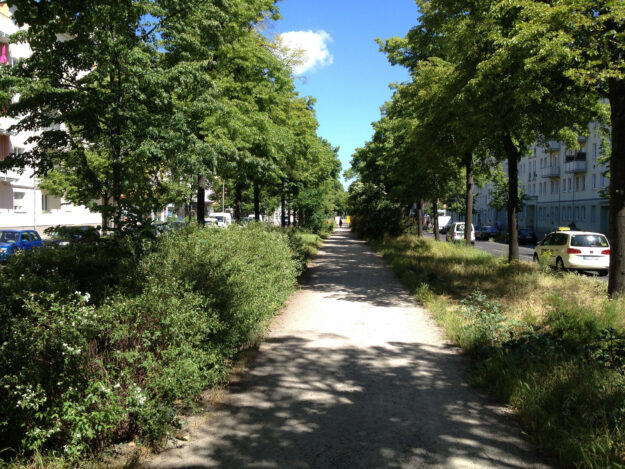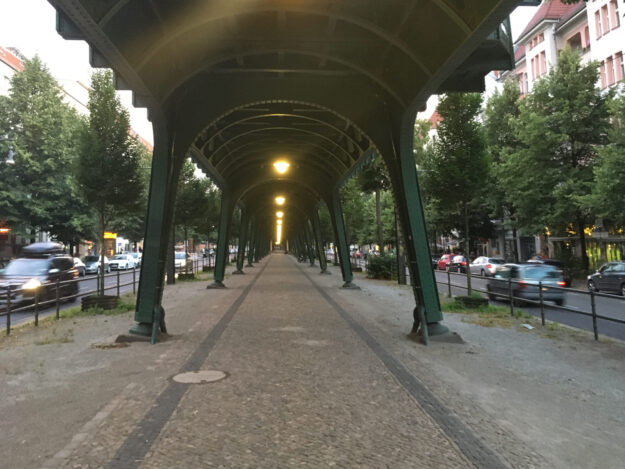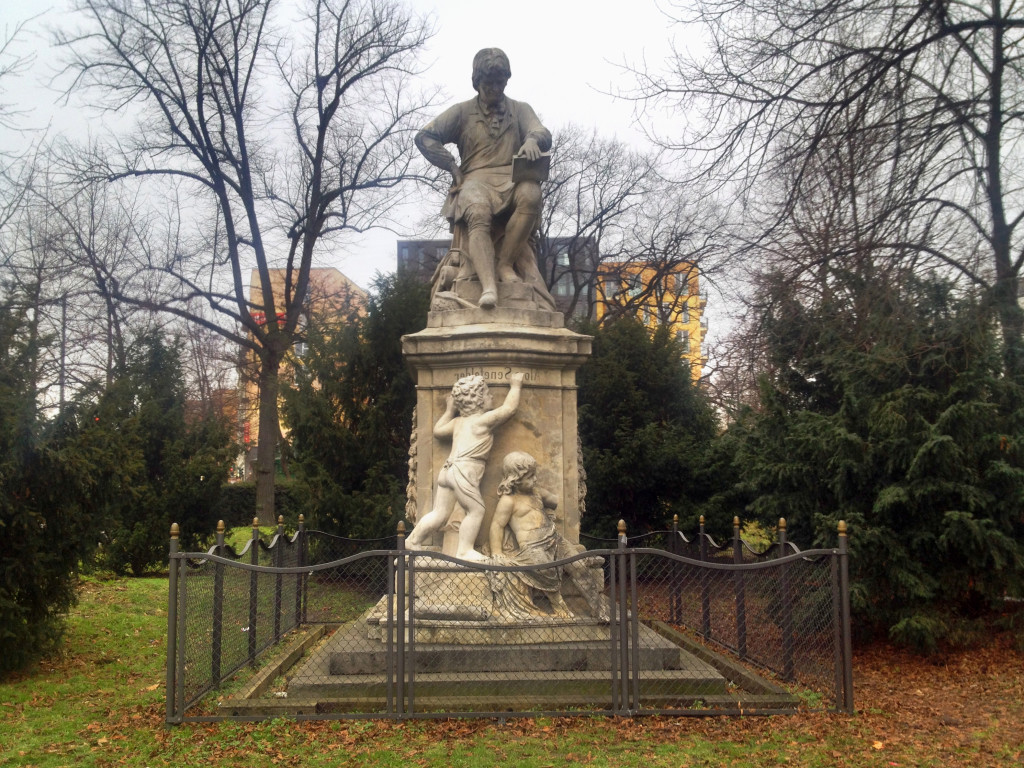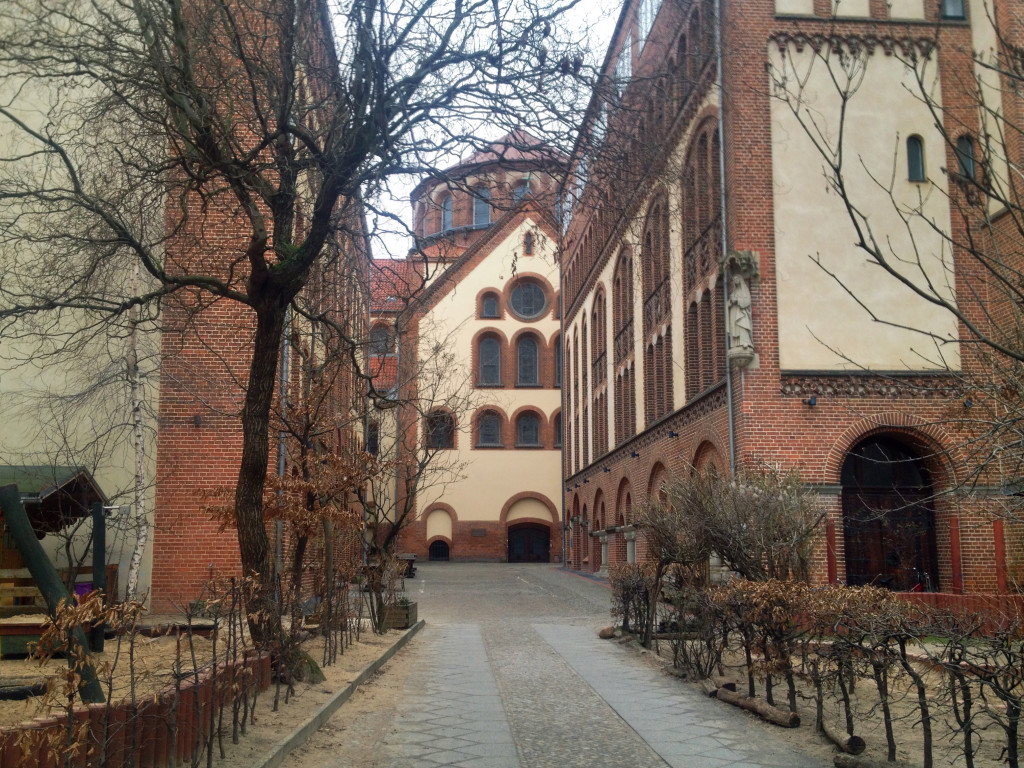The Schönhauser Allee is about 3 km long and has some quite different “faces” on its way from the upper end at Wisbyer Straße down to Mitte / Schönhauser Tor / Torstraße. Today, Schönhauser Allee is only partly a real “avenue” – at least if you would expect rows of trees on the side of a “real” avenue.
The street was originally named after Schönhausen Palace, which is located in Pankow and Niederschönhausen. Taken literally, “Schönhausen” would mean something like “good living” – which certainly corresponds to the cliché attached to the neighborhoods to the left and right of Schönhauser Allee.
Walk along Schönhauser Allee
The first thing you will probably notice when you enter the street is the massive metal viaduct in the middle of Schönhauser Allee. The U2 subway line runs above ground between Westlandstraße / Esplanade (near Wisbyer Straße, Pankow) and Sredzkistraße / Choriner Straße (near Kulturbrauerei).
In addition, the Berlin S-Bahn ring crosses Schönhauser Allee here – and the M1 streetcar line naturally also runs parallel to the U-Bahn here. This makes Schönhauser Allee underground and S-Bahn station an important transfer station. Accordingly, there is always quite a lot going on here.
I like to walk along this section in the middle of Schönhauser Allee, underneath the viaduct, at least a little bit of the way. It’s a very special feeling to have the car traffic and streetcars on both sides next to you – and at the same time to walk underneath the subway, which thunders over you every few minutes.
On the way towards Eberswalder Straße, you will find many small stores and stores on both sides of Schönhauser Allee. But I still wouldn’t describe this section as a typical shopping street. Instead, you’ll find stores for everyday needs: copy stores and drugstores, some butchers, a few bakeries – but of course also some clothing and shoe stores.
About halfway towards Mitte, Schönhauser Allee crosses Gleimstraße, which becomes Stargarder Straße here. Both streets are worth exploring. Gleimstraße leads towards Wedding, Mauerpark and Gleimtunnel, while Stargarder Straße takes you deeper into Prenzlauer Berg, towards Fridrichshain and Kreuzberg.
The fish shop / Fischladen
A little further on, between Gaudystraße and Milastraße, is the FIschladen (www.derfischladen.com). Unfortunately, it’s not so easy to get good fresh fish in Berlin. That’s why the Fischladen is an important institution in Prenzlberg. The Fischladen is a combination of restaurant, snack bar and fish store, so to speak. On the one hand, there is the fish store, where you can get fresh fish and smoked fish as well as seafood and salads, but also fish sandwiches and fish & chips as a snack between meals. Next to it is the restaurant with the characteristic name “Left of the fish store” – on the other side you will find “Right of the fish store”.
Continue in the direction of “Ecke Schönhauser”
Continuing in the direction of Mitte, you come to the intersection of Schönhauser Allee / Eberswalder Straße / Danziger Straße / Pappelallee. The intersection is also known as “Ecke Schönhauser” from the movie of the same name. On one corner is the bread store “Zeit für Brot”, which, like the fish store, is an institution in the KIez. Zeit für Brot naturally bakes its own fresh bread on the spot – and in addition to the different types of bread, there are also various sweet specialties, cakes and sandwiches to take away or eat on the spot.
Those who prefer a warm and hearty meal will find a few more options for a snack at the crossroads: several kebab stands, all of which are well frequented and each have slightly different ideas – and of course the legendary Konnopke snack bar, which has been selling its famous currywurst here for almost a hundred years.
Kulturbrauerei, Frannz Club
A little further on, at the intersection of Schönhauser Allee / Sredzkistraße / Oderberger Straße / Choriner Straße, you will find the Kulturbrauerei and the entrance to the Frannz Club. If you want to go to the Kulturbrauerei, turn left here into Sredzkistraße. To get to Mauerpark, turn right into Oderberger Straße. And if you prefer a quieter walk, you can continue along Choriner Straße from here to Mitte.
Continue towards Mitte
You can now continue your walk to Senefelder Platz in the middle of the street again, but this time above the subway. Here, Schönhauser Allee has a green walkway in the middle, with trees, bushes and a few park benches. So you can either enjoy your walk between rows of trees and bushes and/or take a break on one of the many park benches. Alternatively, you could also turn into Choriner Straße here, for example.
If you continue along the green path, you are actually walking above the U2 subway line. Occasionally you can see the typical ventilation grilles between the bushes, on the sidewalk, next to the road. And every few minutes you can hear a subway train rushing past.
There are very few stores, cafés and restaurants between the Kulturbrauerei and Mitte / Torstraße. But you can perhaps take a look at the old Jewish cemetery, which stretches between Schönhauser Allee, Kollwitzstraße, Knaackstraße and Wörther Straße.
See also:
Next to the cemetery you may notice a large yellow building. It’s a former Jewish Retirement Home / Nursing Home, built in 1880 – 1883. You can find additional information on an information board placed aside the green walk or through Berlin’s official website: Jewish retirement home Schönhauser Allee (scroll down for the english text).

Former Jewish Retirement Home
On the next big street crossing we can find a few interesting details. Schwedter Strasse and Metzer Strasse both begin/end here – both worth walking. And there is a small park called Senefelder Platz, that also the U2 subway station is named after. At the one corner of the park you may find a typical historical Berlin toilet.
Senefelder Platz
At the next major crossroads, we find a few interesting details. Schwedter Straße and Metzer Straße start/end here – both are worth a walk. And there is a small park called Senefelder Platz, after which the U2 subway station here is named.
At one corner of the park you will find a typical historic Berlin toilet – popularly known as Cafe Achteck. After some renovation work, it has been usable again for a few years now.
And a few steps further on you will find a monument to Alois Senefelder, who invented the printing technique of lithography in 1796. On closer inspection of the monument, you will probably notice that Senefelder’s name is written in mirror-inverted script – a direct reference to the printing technique of lithography. And one of the two children is looking at the inscription with the help of a mirror, which shows the lettering upside down.
The Pfefferberg – a former brewery – is also located here. Today, you can find a variety of eateries here, for example the Schankhalle Pfefferberg (schankhalle-pfefferberg.de), the Markthalle Pfefferberg (markthalle-pfefferberg.com) and the Pfefferberg Theater (pfefferberg-theater.de).
Further down, on the opposite side of the street, the former Theresienschule – part of the Herz Jesu Kirche (probably translatable to “Church of the Sacred Heart“) can be seen from Schönhauser Allee.
The catholic girls’ school was closed by the Nazis in 1941 but reopened in 1945. For the following decades the school was the only catholic school in East Germany.
In 1991 the school had to move to Berlin-Weissensee because of the growing request. The rooms in Schönhauser Allee were just too small.
A bit further down you may enjoy a rather nice view to Mitte. The next big street crossing is Torstrasse – Schönhauser Allee end here – or actually continues as Alte Schönhauser Strasse.
You can see the green dome of Berlin Cathedral in the distance.
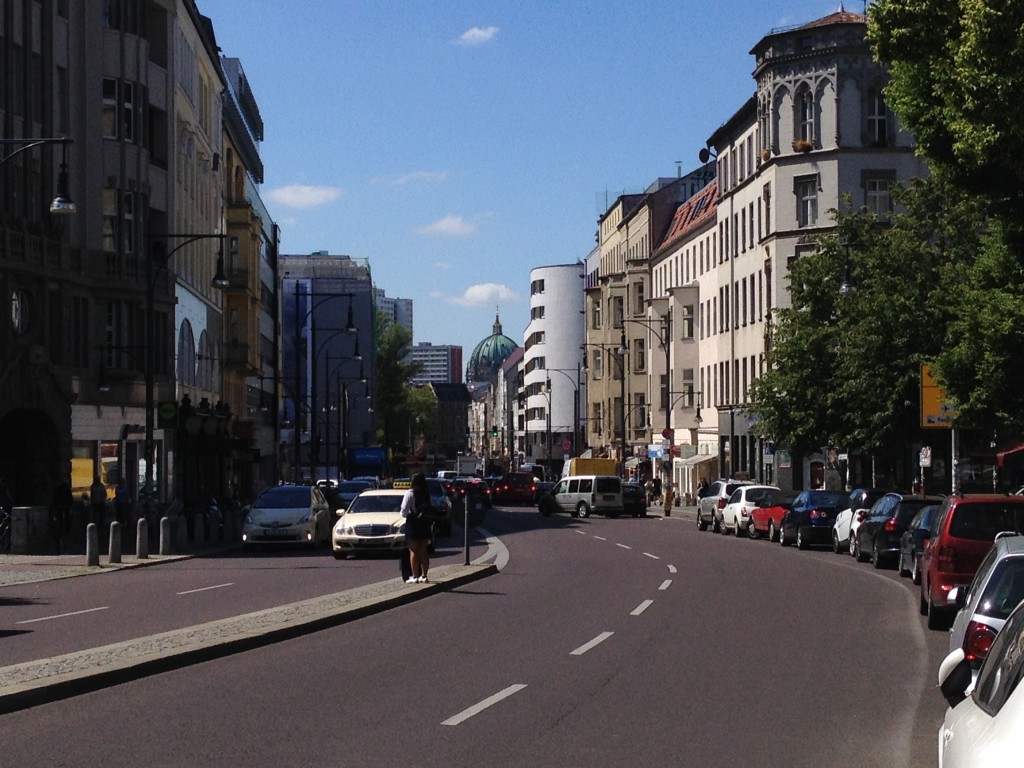
Schönhauser Allee, view to Schönhauser Tor, Berlin Mitte – in the background the green dome of the Berliner Dom
